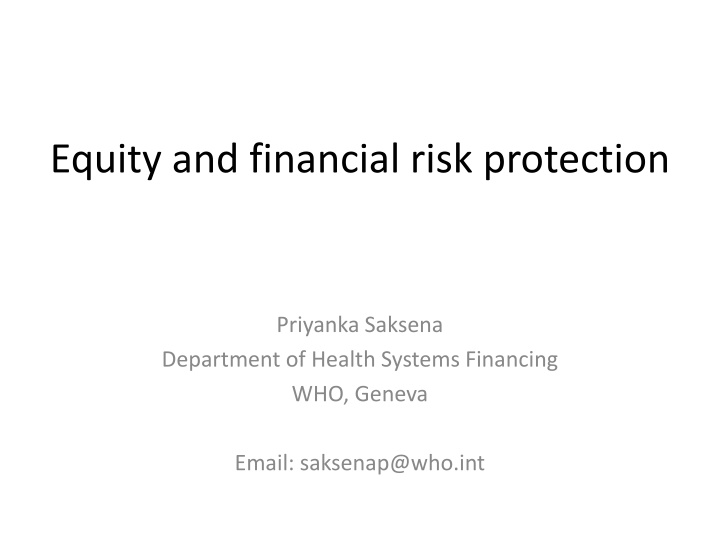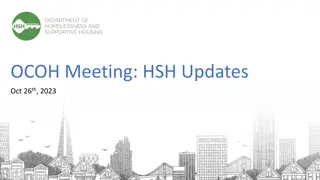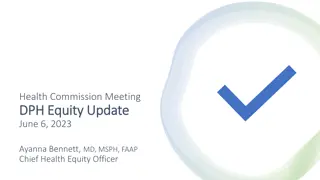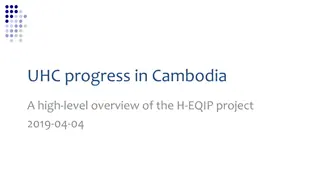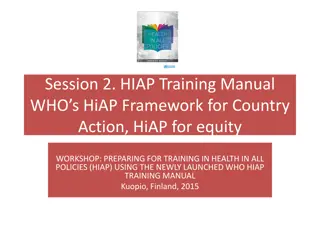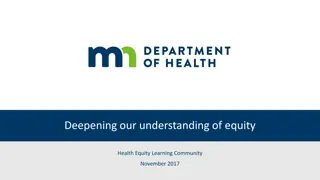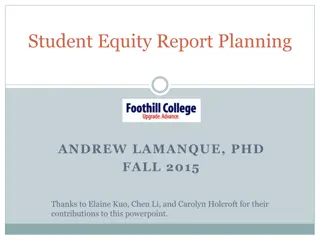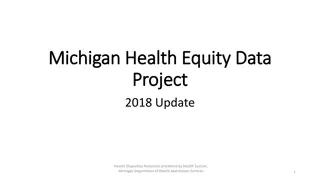Financial Risk Protection and Equity in Health Systems
This content discusses measures of financial risk protection in healthcare, including catastrophic health expenditure and impoverishment due to health payments. It highlights data from countries like Laos and Mongolia on household expenditure and factors affecting catastrophic health expenditure. The content also explores the need and use of health services in Mongolia. Additionally, it references a study from China on factors influencing catastrophic health expenditure and impoverishment from medical expenses, emphasizing the policy implications of universal health insurance.
Download Presentation

Please find below an Image/Link to download the presentation.
The content on the website is provided AS IS for your information and personal use only. It may not be sold, licensed, or shared on other websites without obtaining consent from the author.If you encounter any issues during the download, it is possible that the publisher has removed the file from their server.
You are allowed to download the files provided on this website for personal or commercial use, subject to the condition that they are used lawfully. All files are the property of their respective owners.
The content on the website is provided AS IS for your information and personal use only. It may not be sold, licensed, or shared on other websites without obtaining consent from the author.
E N D
Presentation Transcript
Equity and financial risk protection Priyanka Saksena Department of Health Systems Financing WHO, Geneva Email: saksenap@who.int
Measures of financial risk protection % of households with catastrophic health expenditure Catastrophic overshoot % of households impoverished due to health payments Increase in poverty gap
Q1, Q5 and Average - Catastrophic health expenditure 10 11 12 13 14 Catastrophic expenditure : Range 0%-12% Percentage of households 9 8 7 6 5 4 3 2 1 0 20 40 60 80 100 Q1 Average Q5 Source: Household surveys, 96 countries
Laos - Impoverishment by quintile Laos - Catastrophic health expenditure by quintile 5 5 Percentage of households Percentage of households 4 4 3 3 2 2 1 1 Q1 Q3 Q5 Q2 Q4 Q1 Q3 Q5 Q2 Q4 Source: Laos Expenditure and Consumption Survey 2003 Source: Laos Expenditure and Consumption Survey 2003 Mongolia - Catastrophic health expenditure by quintile Mongolia - Impoverishment by quintile 8 8 7 7 Percentage of households Percentage of households 6 6 5 5 4 4 3 3 2 2 1 1 Q1 Q3 Q5 Q2 Q4 Q1 Q3 Q5 Q2 Q4 Source: Mongolia Household Socio-Economic Survey 2009 Source: Mongolia Household Socio-Economic Survey 2009
Mongolia a further look Need and use of health services Structure of out-of-pocket payments Source: Mongolia Household Socio-Economic Survey 2009
Q1, Q5 and Average - Impoverishment 10 11 12 Mostly Q2 with the highest incidence Percentage of households 9 Impoverishment: Range 0%-5% 8 7 6 5 4 3 2 1 20 40 60 n 80 100 Q1 Q3 Q5 Q2 Q4 Average Source: Household surveys, Low income countries
China Source: Li Y, Wu Q, Xu L, Legge D, Hao Y, Gao L, Ning N, Wan G. Factors affecting catastrophic health expenditure and impoverishment from medical expenses in China: policy implications of universal health insurance. Bull World Health Organ. 2012 Sep 1;90(9):664-71. doi: 10.2471/BLT.12.102178.
Catastrophic overshoot World Health Survey 2003 Source: Saksena, P., Xu, K. & Durairaj, V. 2010. The drivers of catastrophic expenditure: outpatient services, hospitalization or medicines? World Health Report (2010) Background Paper, 21
Depth of poverty Source: Eddy van Doorslaer, Owen O'Donnell, Ravi P Rannan-Eliya, Aparnaa Somanathan, Shiva Raj Adhikari, Charu C Garg, Deni Harbianto, Alejandro N Herrin, Mohammed Nazmul Huq, Shamsia Ibragimova, Anup Karan, Chiu Wan Ng, Badri Raj Pande, Rachel Racelis, Sihai Tao, Keith Tin, Kanjana Tisayaticom, Laksono Trisnantoro, Chitpranee Vasavid, Yuxin Zhao, Effect of payments for health care on poverty estimates in 11 countries in Asia: an analysis of household survey data, The Lancet, Volume 368, Issue 9544, 14 20 October 2006, Pages 1357- 1364, ISSN 0140-6736, http://dx.doi.org/10.1016/S0140-6736(06)69560-3.
Equity and financial risk protection some final thoughts Financial risk protection analysis should always be done side-by-side health service use analysis Disaggregation of OOP is useful Non-food expenditure or non-food based expenditure (like "capacity to pay") is a better denominator for catastrophic health expenditure Engel's Law 1600 Total expenditure/Income 1400 Total food expenditure 1200 1000 800 600 400 200 0 Q1 Q2 Q3 Q4 Q5
Equity and financial risk protection some final thoughts Financial risk protection analysis should always be done side-by-side health service use analysis Disaggregation of OOP is useful Non-food expenditure or non-food based expenditure (like "capacity to pay") is a better denominator for catastrophic health expenditure Engel's Law 1600 Total expenditure/Income 1400 Total food expenditure Non-food expenditure 1200 1000 800 600 400 200 0 Q1 Q2 Q3 Q4 Q5
Equity and financial risk protection some final thoughts Financial risk protection analysis should always be done side-by-side health service use analysis Disaggregation of OOP is useful Non-food expenditure or non-food based expenditure (like "capacity to pay") is a better denominator for catastrophic health expenditure Engel's Law 1600 Total expenditure/Income 1400 Total food expenditure Basic food expenditure 1200 1000 800 600 400 200 0 Q1 Q2 Q3 Q4 Q5
Equity and financial risk protection some final thoughts Financial risk protection analysis should always be done side-by-side health service use analysis Disaggregation of OOP is useful Non-food expenditure or non-food based expenditure (like "capacity to pay") is a better denominator for catastrophic health expenditure Engel's Law 1600 Total expenditure/Income Total food expenditure Basic food expenditure Capacity to pay 1400 1200 1000 800 600 400 200 0 Q1 Q2 Q3 Q4 Q5
Equity and financial risk protection some final thoughts Financial risk protection analysis should always be done side-by-side health service use analysis Disaggregation of OOP is useful Non-food expenditure or non-food based expenditure (like "capacity to pay") is a better denominator for catastrophic health expenditure Engel's Law 1600 Total expenditure/Income Total food expenditure Basic food expenditure Non-food expenditure Capacity to pay 1400 1200 1000 800 600 400 200 0 Q1 Q2 Q3 Q4 Q5
Equity and financial risk protection some final thoughts (cont.) Income/expenditure already build into indicator of financial risk protection (e.g. impoverishment, catastrophic health expenditure) Inequity in financial risk protection across wealth dimensions is very much reflection of inequalities in wealth Equity in financial risk protection will really be important in non-wealth dimensions Impoverishment/catastrophic health do not capture everything Indicators built on cross-sectional data they do not capture the long-term effects of health expenditure How do you take into account the financial/economic hardship faced by a household who because of spending on health care had to pull a child out of school instead to send him/her to work? What is the scope of capturing issues like this?
